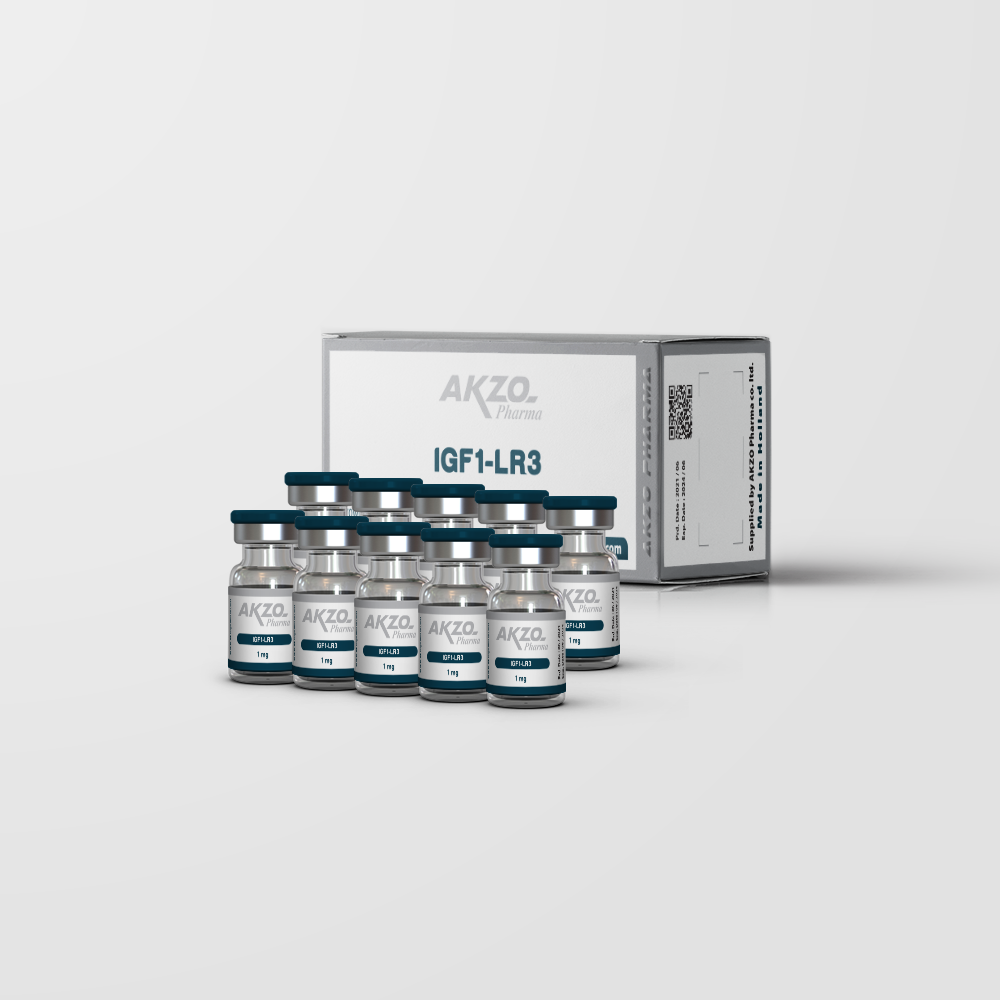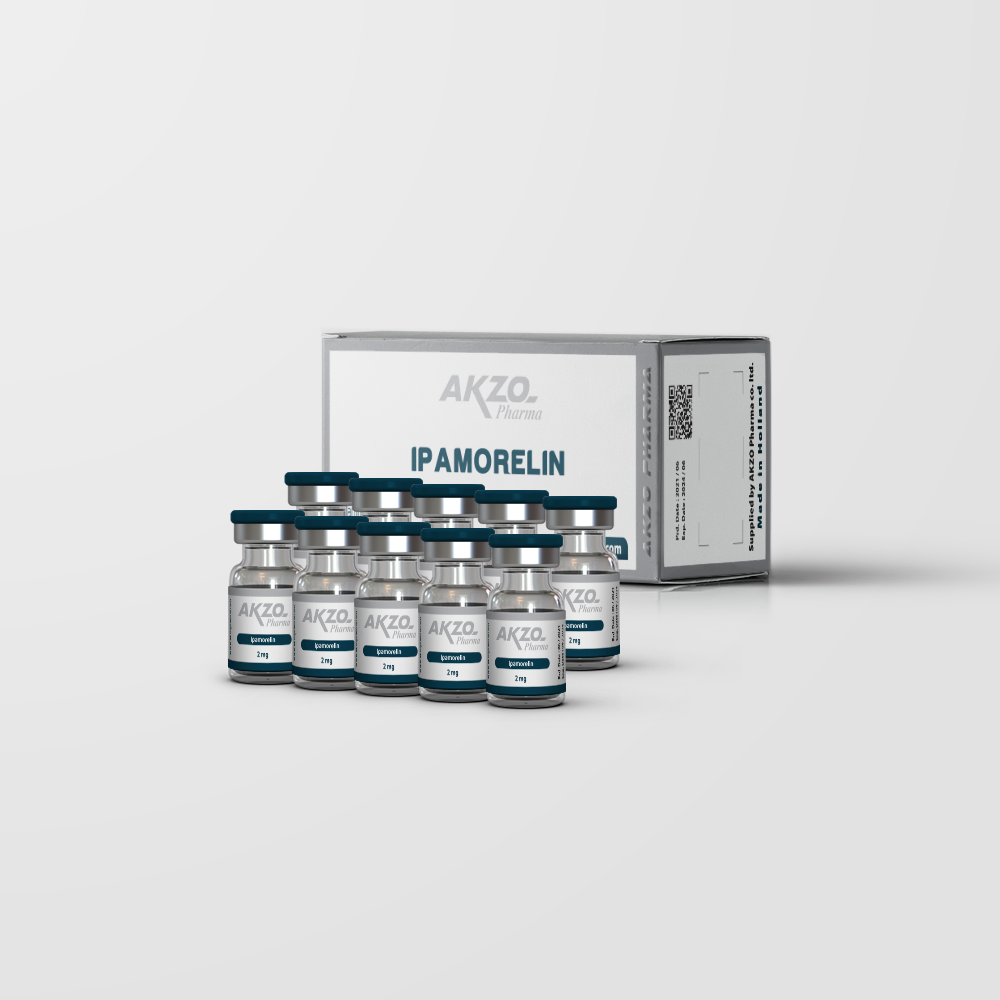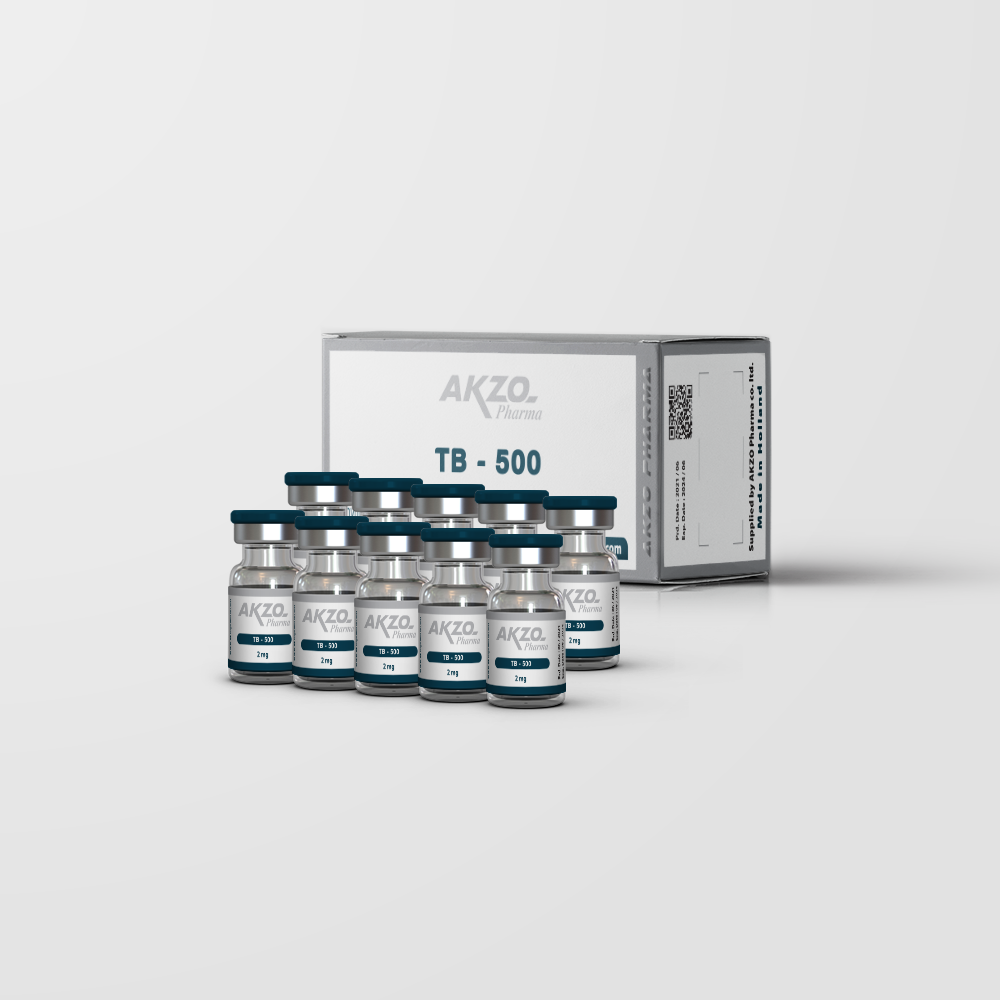SOMATOTROPIN
SOMATOTROPIN
191aa Human Growth Hormone
- POTENCY: 10 iu/vial.
- APPEARANCE: lyophilized (freeze-dried) white powder.
- PACKING: Packing 10 x 10 iu/vials
- DOSAGE: 4 iu – 6 iu/day.

1.Description
Somatotropin (recombinant Human Growth Hormone- Rdna origine) is a human growth hormone produced by recombinant DNA technolnogy. It has 191 amino acid sequence and i are identical to the dominant form of this human pituitary growth hormone. It has a molecular weight of 22,125 daltons. Somapure( rHGH) is a sterile, non-pyrogenic, white lyophilized powder intended for subcu- taneous or intramuscular injection, after reconstitution with sterile Water for Injection (0,3% m-Cresol)
2. Clinical pharmacology
2.1 Mechanism of Action
Somatropin (as well as endogenous HGH) binds to a dimeric GH receptor in the cell membrane of target cells resulting in intracellular signal transduction and a host of pharma- codynamic effects. Some of these pharmacodynamic effects are primarily mediated by IGF- produced in the liver and also locally (e.g., skeletal growth, protein synthesis), while others are primarily a consequence of the direct effects of somatropin (e.g., lipolysis) [see Clinical Phama- cology.
2.2 Pharmacodynamics Tissue Growth
The primary and most intensively studied action of somatropin is the stimulation of linear growth.
This effect is demonstrated in children with GHD.
Skeletal Growth
The measurable increase in bone length after administration of somatropin results from its effect on the cartilaginous growth areas of long bones. Studies in vitro have shown that the incorporation of sulfate into proteoglycans is not due to a direct effect of somatropin, but rather is mediated by the somatomedins or insulin-like growth factors (IGFs). The somatomed ins, among them IGF-I, are polypeptide hormones which are synthesized in the liver, kidney, and various other tissues. IGF-I levels are low in the serum of hypopituitary dwarfs and hypophysectomized humans or animals, and increase after treatment with somatropin.
Cell Growth
It has been shown that the total number of skeletal muscle cells is markedly decreased in children with short stature lackin
endogenous GH compared with nomal children, and that treatment with somatropin results in an increase in both the number and
size f muscle cells.. Organ Growth
Somatropin influences the size of internal organs, and it also increases red cell mass.
Protein Metabolism
Linear growth is facilitated in part by increased cellular protein synthesis. This synthesis growth are reflected which can be quantitated by observing the decline in urinary nitrogen excretion and blood urea nitrogen following the initiation of
by nitrogen retention
somatropin therapy. Carbohydrate Metabolism
Hypopituitary child ren sometimes experience fasting hypoglycemia that may be improved by treatment with somatropin. In healthy subjects, large doses of somatropin may impair glucose tolerance. Although the precise mechanism of the diabetogenic effect of somatropin is not known, it is attributed to blocking the action of insulin rather than blocking insulin secretion. Insulin levels in serum actually increase as somatropin levels increase. Administration of human growth hormone to nomal adults and patients with growth hormone deficiency results in increases in mean serum fasting and postprandial insulin levels, although mean values remain in the normal range. In addition, mean fasting and postprandial glucose and hemoglobin A1 c levels remain in the normal range.
Lipid Metabolism
Somatropin stimulates intracellular lipolysis, and administration of somatropin leads to an in- crease in plasma free fatty acids and
triglycerides. Untreated GHD is associated with increased body fat stores, including increased abdominal visceral and subcutaneous adipose tissue. Treatment of growth hormone deficient patients with somatropin results in a general re- duction of fat stores, and decreased serum levels of low density lipoprotein (LDL) cholesterol.
Mineral Metabolism
Administration of somatropin results in an increase in total body potassium and phosphorus and to a lesser extent sodium. This retention is thought to be the result of cell growth. Serum levels of phosphate increase in children with GHD after somatropin therapy due to metabolic activity associated with bone growth.Serum calcium levels are not altered. Although calcium excretion in the urine is increased, there is a simultaneous increase in calcium absorption from the intestine. Negative calcium balance, however, may occasionally occur during somatropin treatment.
Connective Tissue Metabolism
Somatropin stimulates the synthesis of chondroitin sulfate and collagen, and increases the urinary excretion of hydroxyproline.
3. Indications
Samopure is a prescription product for the treatment of growth failure in children: Who do not make enough growth hormone on their own. This condition is called growth hor- mone deficiency (GHD). With a genetic condition called Prader-Willi syndrome (PWS). Growth hormone is not right for all children with PWS. Check with your doctor. Who were born smaller than most other babies born after the same number weeks of preg- nancy. Some of these babies may not show catch-up growth by age 2 years. This condition is called small for gestational age (SGA) With a genetic condition called Turner syndrome (TS). With idiopathic short stature (ISS), which means that they are shorter than 98.8% of other children of the same age and sex; they are growing at a rate that is not likely to allow them to reach normal adult height, and their growth plates have not closed. Other causes of short height should be ruled out. ISS has no known cause. Somapure is a prescription product for the replacement of growth hormone in adults with growth hormone deficiency (GHD) that started either in childhood or as an adult. Your doctor should do tests to be sure you have GHD, as appropriate.
4. Contraindications Do not use Somapure, if:
– you are allergic to any ingredient in Somapure or in the diluent, including metacresol – you have active or recurring cancer or brain tumor, or you currently receive treatment
for cancer
– you have severe breathing problems (e.g., respiratory failure) or a serious illness caused by complications from a surgery or injury
– you have a certain type of eye problem caused by diabetes (diabetic retinopathy) – the patient is a child who has Prader-Willi syndrome and is severely overweight or has
infection, history of airway blockage or sleep apnea)
– the patient is a child who has epiphyseal closure (bone growth is complete) – Contact your doctor or health care provider right away if any of these apply to you
severe breathing problems (e.g., respiratory
5. Instructions for reconstitution
Powder must be dissolved only with the solvent provided. 1- Apply the needle to the syringe.Remove the plastic cover from the vial
2- Break the top of the ampoule containing the solvent. Remove the plastic cover of the needle. Make sure the needle is well applied This list presents the most serious and/or most frequently observed adverse reactions during treatment with somatropin: Sudden death in p • Intracranial tumors, radiation to the head as children for a first neoplasm and somatropin. • Progression of preexisting scoliosis in pediatric patients Doses of concurrent antihyperglycemic drugs in diabetics may require adjustment Intracranial Hypertension: Exclude preexisting papilledema. May develop and is usually reversible after discontinuation or dose May develop. Evaluate children with the onset of a limp or hip/knee pain. Progression of Preexisting metabolite, cortisol, in hepatic and adipose tissue. GH and somatropin inhibit 111HSD-1. Consequently, individuals with untreated GHD have relative increases in 11iHSD-1 and serum cortisol. Introduction of somatropin treatment may result in inhibition of 11 HSD-1 and reduced serum cortisol concentrations. As a consequence, previously undiagnosed central (secondary) hypoadrenalism may be following initiation somatropin treatment; this may be especially true for patients treated with cortisone acetate and prednisone since conversion of these drugs to their biologically active metabolites is dependent on the activity of 11HSD-1 somatropin in children. Therefore, glucocorticoid replacement dosing should be carefully adjusted in children receiving concomitant liver enzymes (e.g., corticosteroid s, sex steroids, anticonvulsants, cyclosporine). Careful monitoring is advisable when somatropin is administered in combination with other drugs known be metabolized by CYP450 liver enzymes. However, formal drug interaction growth hormone. t 2°C-8°C.
to the syringe. Slowly absorb all the solvent. 3- Inject all the solvent to the vial. This will create a 3,33mg/ml solution. To prevent foaming, the solvent should be injected into the
vial by aiming the stream of liquid against the glass wall.
4- Following reconstitution, the vial should be swirled with a GENTLE rotary motion until the contents are completely dissolved. DO NOT SHAKE. The resulting solution should be clear and colorless, without particulate matter.
6. Adverse reactions
n pediatric patients with Prader-Willi synd rome with risk factors including severe obesity, history of upper airway infectio obstruction or sleep apnea and unidentified respira- tory infection
• Glucose intolerance including impaired glucose tolerance/impaired fasting glucose well s overt diabetes mellitus Intracranial hypertension
Significant diabetic retinopathy
Slipped capital femoral epiphysis in pediatric patients
• Fluid retention manifested by edema, arthralgia, myalgia, nerve compression syndromes including carpal tunnel syndrome /paraesthesias
Unmasking of latent central hypothyroidism • Injection site reactions/rashes and lipoatrophy (as well as rare generalized hypersensitivity reactions) • Pancreatitis
7. Warnings and precautions
Acute Critical Ilness: Potential benefit of treatment continuation should be weighed against the potential risk Prader-Willi Syndrome in Children: Evaluate for signs of upper airway obstruction and sleep apnea before initiation of treatment for
GHD. Discontinue treatment if these signs ocur Neoplasm: Monitor patients with preexisting tumors for progression or recurrence. Increased risk of a second neoplasm in childhood cancer survivors treated with somatropin – in particular meningiomas in patients treated with radiation to the head for their first
neoplasm Impaired Glucose Tolerance and Diabetes Mellitus: May be unmasked. Periodically moni- tor glucose levels in all patients.
reduction. Fluid Retention (edema, arthralgia, carpal tunnel syndrome especially in adults): May occur frequently. Reduce dose as necessary
Hypothyroidism: May first become evident or worsen Slipped Capital Femoral Escoliosis: May develop
Pancreatitis: Consider pancreatitis in patients with persistent severe abdominal pain.
8. Interaction with other drugs
8.1 Inhibition of 11i-Hydroxysteroid Dehydrogenase Type 1 The microsomal enzyme 11i-hydroxysteroid dehydrogenase type 1 (11iHSD-1) is required for conversion of cortisone to its active
unmasked and glucocorticoid replacement may be required in patients treated with somatropin. In addition, patients treated with glucocorticoid replacement for previously diagnosed hypoadrenalism may require an increase in their maintenance or stress doses
8.2 Pharmacologic Glucocorticoid Therapy and Supraphysiologic Glucocorticoid Treatment Pharmacologic glucocorticoid therapy and supraphysiologic glucocorticoid treatment may attenuate the growth promoting effects of
soma tropin and glucocorticoid treatments to avoid both hypo-adrenalism and growth. 8.3 Cytochrome P450-Metabolized Drugs
Limited published data indicate that somatropin treatment increases cytochrome P450 (CYP450)- mediated antipyrine clearance in man. These data suggest that somatropin ad-ministration may alter the clearance of compounds known to be metabolized by CYP450
studies have not been conducted. 8.4 Oral Estrogen
Because oral estrogens may reduce the serum IGF-1 response to somatropin treatment, girls and women receiving oral estrogen
replacement may require greater somatropin dosages.
8.5 Insulin and/or Oral/Injectable Hypoglycemic Agents
In patients with diabetes mellitus requiring drug therapy, the dose of insulin and/or oral/inject- able agent may require adjustment when somatropin therapy is initiated
9. Over dosage
Short-Term Short-term over dosage could lead initially to hypoglycemia and subsequently to hyperglyce- mia. Furthermore, overdose with
somatropin is likely to cause fluid retention. Long-Term
Long-term over dosage could result in signs and symptoms consistent of gigatism and/or consistent with the known effects of excess
10. Storage.
Shelf life
• This product can be used not more than 3 years from the production date (see box)
• After reconstitution, may be stored for a maximum of 14 days in refrigerator at 21 • Store vials in an upright position.
• Store in a refrigerator (2°C-8°C). Keep in the outer carton in order to protect from light
For one month can be stored at room temperature.









